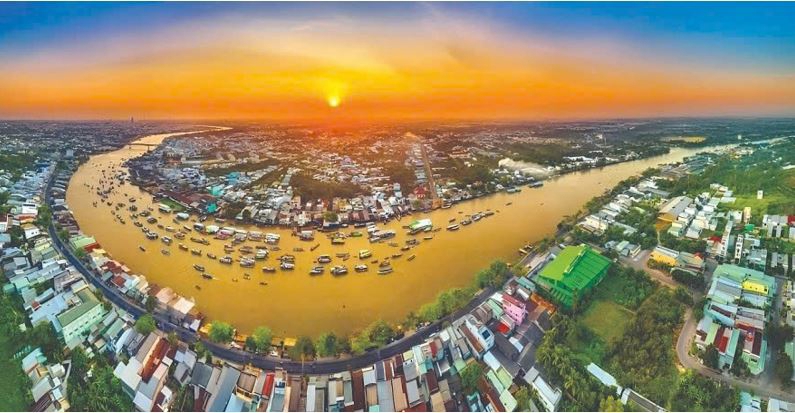The Fulbright School of Public Policy and Management has collaborated with the Vietnam Chamber of Commerce and Industry - Mekong Delta to compile the Mekong Delta Annual Economic Report. Following the research results announced on March 27, the 2024 Annual Mekong Delta Annual Economic Report, with a focus on “Mobilizing Investment for Sustainable Development”, looks at issues surrounding resources, needs, and efficiency as well as investment challenges in the Delta region. It determined that the region posted an increase in gross regional domestic product (GRDP) of 7.3 per cent last year, slightly above the national average of 7.1 per cent and continuing a three-year streak of outperforming the country’s overall growth rate.
Industrial output gained strong momentum, with the region’s Index of Industrial Production (IIP) rising 12.2 per cent; the highest level recorded in the past decade and well above the national benchmark. Meanwhile, trade has rebounded robustly since the pandemic. Total retail sales and consumer service revenues grew 14.4 per cent in 2024, a remarkable rise compared to the national average of 9 per cent.
Poor performance
In addition to such promising figures lies a persistent challenge. The Mekong Delta’s economic structure remains largely unchanged, and it continues to struggle with low levels of public, private, and foreign direct investment (FDI). Public investment in the region ranks just above the central highlands and is on par with the northern midlands and mountainous areas, but significantly trails the north-central and south-central coastal regions, which receive nearly double the public funding.
This chronic underinvestment has long been a critical bottleneck, contributing to the region’s economic stagnation. To unlock its full potential and pursue sustainable growth, the Mekong Delta needs bold policy interventions that not only improve the efficiency of existing investments but also attract and mobilize greater capital from diverse sources.
The share of private investment in the Mekong Delta relative to the national total declined from 14.9 per cent in 2014 to just 12.4 per cent in 2023. Though private investment in the region grew 7.7-fold over the 2014-2023 period, averaging 6.2 per cent annually, this rate still lagged behind the national average of 8.4 per cent a year, or 12.1-fold over the same timeframe.
In the manufacturing and processing sector, private investment made up just 9 per cent of the national total last year, down from 12.9 per cent in 2014. Most of this investment is concentrated in labor-intensive, low value-added industries. High-tech industries, such as electronics, mechanical engineering, and heavy industry, remain virtually absent.
FDI into the Mekong Delta also remains limited. The region attracted just 142 new FDI projects last year with total registered capital of $759 million, accounting for less than 2 per cent of newly-registered FDI nationwide, and significantly lower than other regions. FDI contributes only 6.8 per cent of the region’s total social investment capital, far below the national average of 16.3 per cent.
The report emphasized that this chronic underinvestment is one of the key factors contributing to the Mekong Delta’s prolonged economic stagnation. Despite being Vietnam’s leading hub for agricultural production and exports, contributing over 50 per cent to the country’s trade surplus, the region consistently records some of the lowest levels of investment.
Between 2021 and 2023, total social investment in the region made up only 11.2 per cent of the national figure, down from 13.2 per cent during the 2011-2016 period. This share is even lower than the region’s contribution to national GDP, revealing a clear mismatch between its economic potential and the capital resources allocated for its development.
Key barriers
A survey of 153 private enterprises in the Mekong Delta conducted in the third quarter of 2024 found that only 56.9 per cent of respondents plan to invest in the region over the next five years. Meanwhile, 32 per cent have no plans to expand, and 11.1 per cent intend to invest elsewhere, mainly in the southern region. These figures reflect significant challenges in attracting and retaining investors in the Delta.
Though industries such as technology and startups show relatively high investment interest, others, particularly agriculture and traditional manufacturing, remain less engaged. Most enterprises with plans to invest in the region are only looking to expand on a small scale (less than 25 per cent of their current operations), while just 12 per cent aim for expansions exceeding 50 per cent. Only 12.6 per cent of companies plan to launch new projects. Additionally, 33 per cent of enterprises intend to prioritize investment in research and development (R&D), indicating a growing need for innovation in the face of intensifying competition.
The report identifies four main groups of barriers hindering investment flows into the Mekong Delta.
First, the region suffers from underdeveloped transportation and logistics infrastructure. Road remains the primary method of transport, but there is no comprehensive expressway network that ensures efficient intra-regional and inter-regional connectivity, especially with the southern region. As a result, logistics costs are high, reducing the competitiveness of local businesses.
Second, there is a shortage of skilled workers. While the Mekong Delta has a relatively large workforce, skill levels do not meet the requirements of modern industries such as manufacturing, processing, information technology, and logistics. The limited number of high-quality vocational training centers further restricts local workers’ ability to upgrade their skills.
Third, climate change poses significant risks. Saltwater intrusion, land subsidence, and rising sea levels are having a severe impact on the region, making it less attractive to potential investors.
Fourth, although the government has introduced various incentive policies to attract investment to the Mekong Delta, these measures have not been strong enough to spur significant interest in high value-added sectors. Administrative procedures remain cumbersome, coordination between different levels of government is still lacking, and there are no long-term policies to ensure stability for investors. In some cases, overlapping or outdated policies further complicate project implementation for businesses.
Among these barriers, businesses are most concerned about transportation infrastructure, market access, and construction costs. These concerns highlight the urgent need to prioritize the development of transport infrastructure to stimulate private investment, while also improving the business environment through administrative reforms and enhanced access to land and credit.
Proposed solutions
To reverse the economic decline, the report emphasizes the need for the Mekong Delta to have a comprehensive and long-term investment mobilization strategy, with close coordination between the government, local authorities, and the business community.
It proposes four key solutions to address investment bottlenecks and promote sustainable development for the Mekong Delta.
First, digital transformation should be the focus of investment and development strategies. Prioritizing investment in telecommunications infrastructure and high-speed internet will serve as a foundation for digital governance, digital economy, and digital society.
Second, public investment allocation must be restructured to prioritize transportation and telecommunications infrastructure, logistics, and digital transformation. At the same time, disbursement in key projects should be accelerated, such as the Can Tho - Ca Mau Expressway, the Chau Doc - Can Tho - Soc Trang Expressway, and the agricultural product logistics system.
Third, a favorable environment needs to be created to attract private investment and FDI. Improving administrative procedures, increasing transparency in licensing processes, and enhancing access to land for strategic investors in high-tech agriculture, deep processing industries, and renewable energy are also required.
Fourth, public-private partnership (PPP) models should be developed. Private capital also needs to be mobilized for key infrastructure projects, particularly in transportation and logistics. Additionally, models for ecological rural areas and green cities to improve the quality of life and attract talent should be established.









 Google translate
Google translate